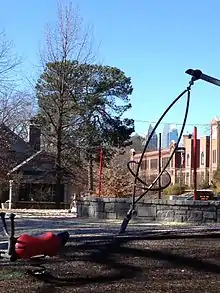John Howell Memorial Park
John Howell Memorial Park is a 2.8 acre park in the Virginia Highland neighborhood of Atlanta.





History
The park is built on the site of 11 houses demolished in the mid-1960s, when the Georgia State Highway Department proposed building Interstate 485 to connect what is now Freedom Parkway through Virginia-Highland to what is now Georgia 400 at Interstate 85. The park site would have been the Virginia Avenue exit off the freeway.
I-485 was finally defeated, and The Georgia Department of Transportation began selling the properties it had acquired. In 1988, the park opened.
In the early 1980s, the Virginia Highland Civic Fund, Inc. was created to plan and develop the space. The park design emerged from a study broadly distributed broadly across the neighborhood. In the late 1980s, the Living AIDS Memorial Park Project and Volleyball Atlanta joined the effort and provided fundraising and technical help.
In 1989, the park was named after Virginia-Highland resident and anti-freeway activist John Howell, who died from complications of HIV in 1988.
Peter Frawley & Associates, a local landscape architectural firm, coordinated all the input. In February, 1993, the Atlanta City Council approved the final plan for the park. The decade-long fund raising and construction project was headed by Jerry Bright and Rick Porter. The John Howell Park Project corporate minutes from 1985-2000 and other historical documents are available at the Emory University Library in Atlanta.
Features
Features of the park, from west to east, are:
- Volleyball courts installed in 1982, the oldest sand volleyball courts in Atlanta. Virginia Highland Volleyball Association
- Cunard Memorial playground, a children's playground dedicated in 2004 honoring neighborhood residents Lisa, Max, and Owen Cunard who were killed in the summer of 2003 by a falling tree during a storm while driving along N. Highland Avenue
- Wrought iron sculpture of a stylized phoenix, the symbol of the City of Atlanta. In March 2000, a plaque describing the history of the Park was added.
- A circular pathway paved with commemorative bricks; the sale of the bricks supported park maintenance.
Along Virginia Avenue are eleven granite columns, each of which bears the address of one of the homes that were demolished.